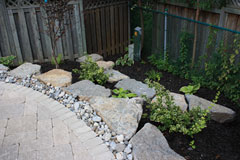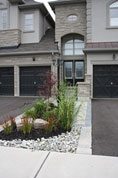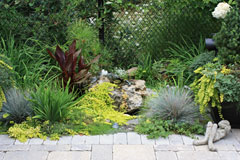4 Surprising Factors That Can Inflate the Cost of Your Outdoor Project
There are a handful of factors that consistently lead to homeowners experiencing higher landscaping costs than they anticipated- some are beyond their control, and some are manageable.
Here are the top 4 factors that can increase your landscaping costs, and how to best conquer them, if possible:
1. Slope and Elevation
 Slope and ElevationEvery property is unique. The size and shape of a lot, its slope, existing trees and vegetation, soil conditions and other physical features make each piece of property either more or less suited for different types of construction and activities. The very things that make your yard interesting and scenic will sometimes create challenges when you plan landscape projects.
Slope and ElevationEvery property is unique. The size and shape of a lot, its slope, existing trees and vegetation, soil conditions and other physical features make each piece of property either more or less suited for different types of construction and activities. The very things that make your yard interesting and scenic will sometimes create challenges when you plan landscape projects.
Extreme slope can commonly lead to challenges. All properties have some amount of slope. To the surprise of many homeowners, both very flat and very steep sites present challenges for landscaping.
Unless the soil is sandy, flat yards generally do not drain well. The soil becomes soggy, making conditions difficult for plant material and construction. Extra drainage materials and soil amendments will be needed to make sure that any landscape improvements will have a normal lifespan with minimal problems.
A steep yard is also challenging. In order to create usable space, there is often a significant amount of earthwork required. Retaining walls can be used to minimize potential damage to existing trees or to lessen the disturbed area. Both of these things can make a project more interesting and successful, but they will add cost.
2. Backyard Access
 Backyard AccessGetting people and equipment to and from a landscape project site is sometimes the most difficult part of the work. If you have a very narrow side yard or any obstacles such as trees or fences, the only backyard access might be through your house. In some situations, the best access route is across the next door neighbor’s property. All of this means that extra time, effort and care will have to be factored into the project cost.
Backyard AccessGetting people and equipment to and from a landscape project site is sometimes the most difficult part of the work. If you have a very narrow side yard or any obstacles such as trees or fences, the only backyard access might be through your house. In some situations, the best access route is across the next door neighbor’s property. All of this means that extra time, effort and care will have to be factored into the project cost.
It is possible to accommodate all types of access- including workers removing shoes and walking through the home to transport materials- but these issues will always lengthen the amount of time a project takes and increase the price.
3. Paying Others to Fix Your Mistakes
Do-it-yourself projects are an effective way to save money for those that have the ability and available time. There is nothing wrong with do-it-yourself work, but be sure you know what you are doing!
An incorrectly planted tree will either die or refuse to grow. Hardscape construction features such as stone walls or concrete paver patios may fail or fall apart if they are built incorrectly. If you don’t have the experience, it’s better to pay a professional to do it right the first time. Otherwise, you will be paying them to both take apart your work and put it back together.
4. Short Term Versus Long Term Costs

An experienced landscape professional can help you make these kinds of decisions. Whether it’s physical features or previous poor planning, they will tell you all of the factors that determine the cost of your landscaping project. Very few of us live in places with gently sloping yards with no obstacles or other complications. Just remember, the things they make our landscapes more challenging also make them special and more interesting.
If you’re ready for a consultation to find out what your project will cost, contact us now.
- WHY TRUST IS SO IMPORTANT TO US - December 15, 2019
- MORE ON LANDSCAPE LIGHTING - February 16, 2019
- 5 Ways Landscaping Can Increase Your Home Value - January 5, 2019
